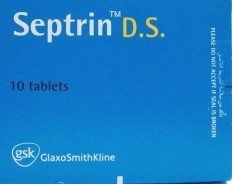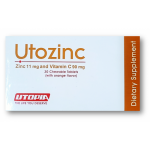
Septrin (Trimethoprim + Sulfamethoxazole)
ORAL PRESENTATIONS
QUALITATIVE AND QUANffiATIVE COMPOSITION :
Formulation Trimethoprim content Sulfamethoxazole content
Adult Tablet 80 mg 400 mg
Disoersible 80 mg 400 mg
Double Strength Forte 160 mg 600 mg
Paediatric Tablets 20mg 100 mg
Capsules 80 mg 400 mg
Adult Oral Suspension 80 mg per 5ml 400 mg per 5ml
Paediatric Suspension 40 mg per 5ml 200 mg per 5 ml
PHARMACEUTICAL FORM:
Tablets : Dispersible tablets.
Capsules : Oral suspension.
CLINICAL PARTICULARS :
Indtcations :
SEPTRIN should only be used where, in the judgment of the physician. the benefits of treatment outweigh any possible risks;
consideration should be given 10 the use of a single effective antibacterial agent. The in vitro susceptibility of bacteria to antibiotics varies geographically and with time; the local situation should always be considered when selecting antibiotic therapy.
Urinary tract Infections :
Treatment of acute uncomplicated urinary tract infections. It is recommended that initial episodes of uncomplicated urinary tract
infections be treated with a single effective antibacterial agent rather than the combination.
Respiratory tract Infections :
Treatment of otitis media. SEPTRfN is not indicated for prophylactic Of prolonged administration in otitis media.
Treatment of acute exacertatons of chronic bronchitis.
Treatment and prevention of Pneumocystis jiroveci (P. cann;,) pneumonitis (see Dosage and Administration and Adverse Reactions).
Genital tract infections :
Treatment of gooorrhoea, including oro-pharyngeal and ano-rectal infectioll (see Dosage and Administration). This regimen is less
effective in some parts of the world due to disease caused by resistant organisms. Treatment of chancroid (see Dosage and Administration). This regimen may be less effective in some parts oflhe world due to disease caused by resistant organisms.
Treatment of granuloma inguinale (venereum) (see Dosage and Administration).
Gastrointestinal tract infections :
Clinicians should be aware that first line therapy in the management of all patients with diarrtoeal disease is the maintenance of
adequate hydration. Treatmenl of cholera, as an adjunct to fluid and electrolyte replacement, when the organism has been shown to be sensitive in vitro. Treatment of shigellosis, this regime may be less effective in ‘some parts of theworkl due to resistant organisms.
Treatment of travellers’ diarrhoea (including gastroenteritis due to enterotoxigenic E. coil).
Other bacterial hifections caused by sensitive organisms :
There are a number of other bacterial infections caused by sensitive organisms for which treatment with SEPTRIN may be appropriate;
the use of SEPTRIN in such conditions should be based on dinical experience and local in vitro data. Treatment of nocardiosis (see Dosage and Administration).
SEPTRIN may be useful In:
– toxoplasmosis .
– brucellosis (second-tine therapy), when used in combination with gentamicin or rifampicin
– melioidosis, when used in combination with ceftazidime or cefoperazoneJsulbactam.
Dosage and Administration :
I1 may be preferable 10 take SEPTRIN with some food or drink to minimise the possibility of gastroinlestinal disturbances. Unless otherwise specified STANDARD DOSAGE applies.
Where dosage is expressed as “tablets” this refers to the adult tablet, l.e. 80 mg trimethoprim and 400 mg sulfamethoxazole. If other
formulations are to be used appropriate adjustment should be made.
Acute Infections :
– Adults and children over 12 yealS
STANDARD DOSAGE
Tablets/Capsules 2 every 12 hours
Double strength Tablets 1 every 12 hours
Adult Suspension 10 ml every 12 hours
– Children aged 12 years and under
STANDARD DOSAGE
age Paediatric Tablets Paediatric Susoension
6 to 12 years 4 every 12 hours 10ml every 12 hours
6 months to 5 Years 2 everv 12 hours 5 ml every 12 hours
6 weeks to 5 months 2.5 ml every 12 hours
This dosage approximates to 6 mg trimethoprim and 30 mg sulfamethoxazole per kilogram body weight per 24 hours.
Treatment should be continued until the patient has been symptom free for two days; the majority will require treatment for at least
5 days. If clinical improvement is not evident after 7 days’ therapy, the patient should be reassessed. As an alternative to STANDARD DOSAGE for acute uncomplicated lower urinary tract infections, short term therapy of 1 to 3 days’ duration has been shown to be effective.
– Elderly
See Wamings and Precautions.
– Renal impairment
Adults and d1ildren over 12 years (no information is available for chldreo under 12 years of age).
Measurements of plasma concentration of su/famethoxazole at intervals of 2 to 3 days are recommended in samples obtained
12 hours after administration of SEPTRJN. If the concentration of total sulfamethoxazole exceeds 150 micrograms/ml then treaf(nent
should be interrupted until the value falls below 120 microgramslml.
Pneumocystis jiroveci (P. c.rlnll) pneumonitis :
Treatment:
A higher dosage is recomrrended, using 20 mg trimethoprirn and 100 mg sulfamethoxazole per kg of body weight per day in two
or more divided doses for two weeks. The aim is to obtain peak plasma or serum levels of IJimethoprim of greater or equal to
5 microgramslml (verified in patients receiving 1 hour infusions of intravenous SEPTRJN) (see Adverse Reactions).
Prevention:
• Adults
The following dose schedules may be used:
– 160 mg trimethoprim 1800 mg sulfamethoxazole daily 7 days per week
– 160 mg trimethoprim /800 mg sulfamethoxazole three times per week. on alternate days
– 320 mg trimethoprim /1600 mg sutfamethoxazole per day in two divided doses three times per week on alternate days.
• Children
The following dose schedules may be used for the duration of the period at risk (see Dosage and Administration, Acute Infections,
Children):
– standard dosage taken in two divided doses, seven days per week
– standard dosage taken in two divided doses, three times per week on alternate days
– standard dosage taken in two divided doses, three times per week on consecutive days
– standard dosage taken as a single dose, three times per week 00 consecutive days.
The daily dose given on a treatment day approximates to 150 mg trimethoprimlm2/day and 750 mg sulfamethoxazole/m2/day. The total daily dose should not exceed 320 mg trimethoprim and 1600 mg su/famethoxazole.
Gonorrhoea :
In uncomplicated cases 4 tablets every 12 hours for two days or
5 tablets followed by a further 5 tablets ~hl hours laler Of
10 tablets once daily for 3 days. If poor patient compliance is expected a single dose of 8 tablets taken under supervision may be employed. Oro-pharyngeaJ gonococcal infection: 2 tablets three times daily for seven days.
Chancroid :
2 tablets twice daily for 7 days. If no evidence of healing is apparent after 7 days a further 7 days treatment can be considered.
However, physicians should be aware that failure to respond may indicate that the disease is caused by a resistant Of98nism. Granuloma inguinale :
2 tablets twice daily for up to 2 weeks.
Nocardiosis :
There is no consensus on the most appropriate dosage. Adult doses of 6 to 8 tablets daily for up to 3 months have been used.
Brucellosis :
It may be advisable to use a higher than standard dosage initially. Treatment should continue for a period of at least four weeks and
repeated courses may be beneficial. SEPTRfN should be given in combination with gentamicin Of rifampicin.
Melioidosis :
8 mg/l(glday bimethoprim and 40 mg/I(gIday sulfamethoxazole in divided doses, 3 Of 4 times per lJdy to( 6 months given in
rombination with ceftazidime Of cefoperazonelsulbactam.
Contraindication :
SEPTRIN should not be given to patients with a history of hypersensitivity to sulphonamides, bimethoprim, oo-trimoxazole’ or any excipieots of SEPTRIN. SEPTRIN should not be given to premature babies Of 10 full-term infants in the neonatal period.
Warnings and Precautions :
Fatalities, although very rare, have occurred doe to severe reactioos including Stevens-Johnsoo syndrome, lyell’s syndrome (toxic:
epidermal necroIysis), fulminant hepatic necrosis, agranulocytosis, aplastic anaemia, other blood dysaasias and hypemnsiIiviIy of
therespiralolylract SEPTRIN should be discontinued at the first appearance of skin rash (see Adverse Reactions). Particular care is always advisable when treating elderty patients because, as a group, they are more susceptible to adverse reactions and more likely to suffer serious effects as a result particularly when complicating conditions exist, e.g. impaired kidney aod/or liver function and/or concomitant use of other drugs. For patients with known renal impairment special measures should be adopted (see Dosage and Administration). AA adequate urinary output should be maintained at all times. Evidence of crystalluria in VIVo is rare, although sulphonamide aystaIs have been noted in cooled urine from treated patients. In patients suffering from malnutrition the risk may be increased.
Exercise caution when treating patients with severe hepatic parenchymal damage as changes may occur in the absorption and
metabolism of bimethoprim and sutfamethoxazole. Regular monthly blood counts are advisable when SEPTRIN is given for long periods, or to folate deficient patients or to the elderty, since there exists a possibility of asymptomatic changes in haematologicallaboratory indices due to lack of available folate. These changes may be reversed by administration of folinic acid (5 to 10 mg/day) without interfering with the antibacterial activity.
A folale supplemenl shoo~ also be oonsidered wiIh prolonged high dosage of SEPTRJN (see JnteracOOns). In gl~le dehydrogenase (G<l-PD) delicient palienlS haemolysis may occur.
SEPTRfN should be given with caution to patients with severe allergy or bronchial asthma. SEPTRIN should nol be used in the treabnent of streptococcal pharyngitis due to Group A beta-haemolytic streptococci; eradication of
these organisms from the oropharynx is less effective than with penicillin. Trimethoprim has been noted to impair phenylalanine metabolism but this is of no Significance in phenylketonuric patients on appropriate dietary restriction.
The administration of SEPTRIN 10 patients known or suspected to be at risk of acute porphyria should be avoided. Both trimethoprim
and sulphonamides (although not specffically sulfamethoxazole) have been associated with dinical exacerbation of porphyria.
Dose monitoring of serum potassium and sodium is warranted in patients at risk of hyptrtalaemia and hyponatraemia.
Except under careful supervision SEPTRIN should not be given to patients with serious haematological disorders (see Adverse
Reactions). Trimethoprim-sulfamethoxazole has been given to patients receiving cytotoxic therapy with little or no additional effect on the bone marrow or peripheral blood.
Interactions :
In elderly patients concurrently receiving diuretics, mainly thiazides, there appears to be an inaease<l risk ofthrombocytopenia.
Occasional reports suggest that patients receiving pyrimethamine at doses in excess of 25 mg weekly may develop megaloblastic
anaemia should SEPTRIN be prescribed concurrently.
In some situations, concomitant treatment with zidovudine may increase the risk of haematological adverse reactions to SEPTRfN. If
concomitant treatment is necessary, consideration should be given to monitoring of haematological parameters. Administration of trimethopf’im Isulfamethoxazole 160 mg/800 mg (SEPTRIN) causes a 40% increase in lamivudine exposure because of the bimethoprim component. Lamivudine has no effect on the pharmacokinetics of trimethoprim or sulfamethoxazole. SEPTRIN has been shown to potentiate the anticoagulant activity of warfarin via stereo-selective inhibition of its metabolism. Sulfamethoxazole may displace warfarin from plasma-albumin protein-binding sites in vitro. Careful control of the anticoagulant therapy during treatment with SEPTRIN is advisable. SEPTRIN prolongs the half·life of phenytoin and if co-administered the presaiber should be alert for excessive phenytoin effect. Close monitoring of the patient’s condition and serum phenytoin levels is advisable.
Interaction with sulphonylurea hypoglycaemic agents is uncommon but potentiation has been reported. Concurrent use of rifampicin and SEPTRIN results in a shortening of the plasma half-life of trimethoprim after a period of about one week. This is oot thought to be of dinical significance. Reversible deterioration in renal function has been observed in patients treated with SEPTRfN and cyc\osporin following renal transplantation.
When bimethoprim is administered simultaneously with drugs that form cations at physiological pH, and are also partly excreted by
active renal secretion (e.g. procainamide, amantadine), there is the possibility of oompetitive inhibition of this process which may lead
to an increase in plasma concentration of one or both of the drugs. Concomitant use of trimethoprim with digoxin has been shown to increase plasma digoxin levels in a proportion of elderly patients.
Caution should be exercised in patients taking any other drugs that can cause SEPTRlN may increase the free plasma levels of methotrexate. If SEPTRin is considered appropriate therapy in patients receiving other antt-:aate drugs such as methotrexate, a folate supplement should be considered (see Warnings and Precautions).
Laboratory tests interactions :
Trimethoprim interferes with assays for serum methotrexate when dihydrofolate reductase from LactobaciIfus casei is used in the
assay. No interference occurs if methotrexate is measured by radio-ffnmune assay. Trimethoprim may interfere with the estimation of serum/plasma creatinine when the alkaline picrate reaction is used. This may result in overestimation of serum/plasma creatinine of the order of 10%. Functional inhibition of the renal tubular secretion of creatinine may produce a spurious fall in the estimated rate of creatinine clearance.
SEPTRJN may affect the results of thyroid function tests but this is probably of little or no clinical significance.
Pregnancy and Lactation :
Trimethoprim and sulfamethoxazole cross the placenta and their safety in human pregnancy has not been established. Trimethoprim
is a folate antagonist and, in animal studies, both agents have been shown to cause foetal abooonal!ties (see PnH:IinicaJ Safety
Data). Case-control studies have shown that there may be an association between exposure to fciate antagooists and birth defects
in humans. Therefore SEPTRJN shooId be avoided in pregnancy, particularly in the first trimester, unless the potential benefit to the
mother outweighs the potential risk to the foetus; folate supplementation should be considered if SEPTRIN is used in pregnancy. Sulfamethoxazole competes with bilirubin for binding to plasma albumin. As significant maternally derived drug levels persist for several days in the newbom, there may be a risk of precipitating or exacerbating neonatal hyperbilirubinaemia, with an associated theoretical risk of kernicterus, when SEPTRIN is administered to the mother near the time of delivery. This theoretical risk is particularly relevant in infants at increased risk of hyperbilirubinaemia, such as those who are preterm and those with
glucose-6-phosphate dehydrogenase deficiency. Trimelhoprim and sulfamelhoxazole are excreted in breast milk. Administration of SEPTRIN should be avoided in late pregnancy and in lactating mothers where the mother or infant has, or is at particular risk of developing, hyperbilirubinaemia. Additionally, administration of SEPTRIN should be avoided in infants youngef than eight weeks in view of the predisposition of young infants to hyperbilirubinaemia.
Effects on Ability to Drive and Use Machines Nodala.
Adverse Reactions :
As SEPTRIN contains trimethoprim and a sulphonamide the type and frequency of adverse reactions associated with such compounds
are expected to be consistent with extensive historical experience.
Data from large published dinical trials were used to determine the frequency of very common to rare adverse events. Very rare
adverse events were primarily determined from post.manteting experience data and therefore refer to reporting rate rather than a
“true” frequency. In addition, adverse reactions may vary in their incidence depending on the indication. The following convention has been used for the dassification of adverse events in terms of frequency:
overdose :
lausea, vomiting, dizziness and confusion are likely signs/symptoms of overdosage. Bone marrow depression has been reported il
trimethoprim overdosage. ‘vorMing has not occurred rduction of ‘I>II1iting may be desirable. Gastric lavage may be useful, though absO<ption from the astrointestinal tract is normalfy very rapid and complete i1 approxinatety two hours. This may not be the case in gross overdosage. &pendent oolhe status of renal fundion, administration of fIuifs is reconvnended if ume output is low.
loth trimetho!>rim and active are diatysable by haemodialysis. Peritoneal dialysis is not effective
pharmacodynamics :
in vitro Activity :
sulfamethoxazole competitively mibils the utilisation of para-aminobenzoic acid in the synthesis of dihydrofolate by the bacterial cell resulting in bacteriostasis. Trimethoprim reversibits mbits bacterial cfohydrofolate reductase (OHFR), an enzyme active in the folate 1eIaboic pathway dihydrofolate to tetrahydrofolate. IlepencWlg on the oonditions the effect may be bactericidal. Thos
imethoprim and sutlarnelhoxazole block two consecutive steps ~ the biosynthesis of puriMs and theratore nucloic acids essential tsutfamethoxazole.
Pre clinical safety Data :
Reproductive toxicology: at doses of the excess of the recommended human therapoutic dose, trimethoprim and sulfamethoxazole
have been repor1ed 10 cause deft palale and other foetal abnormalities in rats, findings typical of a folate antagonist Effects with trimethoprim were preventable by co administration of dietary folate. In rabbits, foetal loss was seen at doses of trimethoprim in excess of human therapeutic doses.
Special Precautions for Storage :
Protect an SEPTRIN products from light
Keep SEPTRIN dispersible tablets and capsules dry.
Instructions for Use/Handling :
SEPTRIN Adult and Paediatric Suspensions may be diluted with Syrup BP.
Although they may show some sedimentation such dilutions remain stable for at least a month. Shake thoroughly before use.
Not all presentations are available in every country.
KEEP ALL MEDICAMENTS OUT OF THE REACH OF CHILDREN
Manufactured by:
GlaxoSmithKJine S.A.E., El Salam City, Cairo, AR.E.
Under license from the GlaxoSmithKline group of companies

